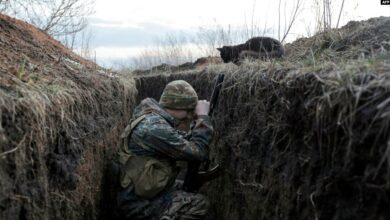‘Draft’ letter saying US forces to leave Iraq was sent by ‘mistake,’ Milley says
'CJTF-OIR will be repositioning forces over the course of the coming days and weeks,' US general tells Iraqi Joint Operations Command
Troops from the U.S.-led Coalition against Islamic State are preparing to leave Iraq, a U.S. general said in a letter, after the country’s parliament voted in favor of expelling foreign forces from the country in the wake of the U.S. airstrike that killed a top Iranian commander and the head of an Iraqi militia.
But U.S. Secretary of Defense Mark Esper later said there was “no decision whatsoever to leave Iraq” and the Chairman of the Joint Chiefs of Staff General Mark Milley said the letter was a draft that should not have been sent.
In the letter to the Iraqi Joint Operations Command dated Monday, January 6, Task Force-Iraq commander Brigadier General William H. Seely wrote, “In due deference to the sovereignty of the Republic of Iraq, and as requested by the Iraqi Parliament and Prime Minister, CJTF-OIR will be repositioning forces over the course of the coming days and weeks to prepare for onward movement.”
“In order to conduct this task Coalition Forces are required to take certain measures to ensure that the movement out of Iraq is conducted in a safe and efficient manner.”
The letter said there would be an increase in nighttime helicopter traffic and around Baghdad’s ultra-secure Green Zone, including CH-47, UH-60, and AH-64 security escort helicopters.
#Breaking: US military tells Iraqi Joint operations command that they are preparing to move out. pic.twitter.com/yqoFiEIHBD
— Mustafa Salim (@Mustafa_salimb) January 6, 2020
The Coalition did not immediately reply to a request for verification of the letter. Washington Post reporter Mustafa Salim, who first reported the letter, said a US military and Iraqi government source had confirmed it, and AFP reported it was authentic, citing U.S. and Iraqi defense sources.
Rick Dickson, a U.S. Army Public Affairs Officer for the 3rd Special Forces Group, tweeted that the letter was “confirmed as official and accurate by Task Force Iraq Public Affairs.”
It was unclear whether the letter referred only to U.S. troops or to other Coalition nations’ personnel, and what the timeline was for the movement.
U.S. Secretary of Defense Mark Esper later told reporters at the Pentagon there was “no decision whatsoever to leave Iraq.”
“That letter is inconsistent with where we are right now,” Esper added.
The Chairman of the Joint Chiefs of Staff General Mark Milley said the letter was “genuine” but a “draft” not intended to be sent at this time.
“This was a mistake,” Milley told reporters. “It was a mistake, an honest mistake, a draft unsigned letter, because we are moving forces around.”
He said it was “poorly worded” and was actually meant to indicate the US was shifting troops between bases, and not withdrawing.
“It shouldn’t have been sent,” Milley said.
On Friday, the U.S. killed Iran’s Quds Force commander General Qassem Soleimani and Abu Mahdi al-Muhandis, head of Kataib Hezbollah and the de facto leader of Iraq’s Hashd al-Shaabi militias, in an airstrike outside Baghdad international airport.
After caretaker Prime Minister Adel Abdul Mahdi vowed to expel U.S. troops from the country in response, Iraqi lawmakers voted on Sunday to end a security agreement with the U.S. and the Iraqi government could force American forces to withdraw.
The resolution calls for the end of the presence of foreign forces on Iraqi soil and prohibition of its “land, air space or water for any reason.” U.S. operations against ISIS in Iraq are carried out in accordance with a 2014 agreement with the former government.
There are officially about 5,000 U.S. troops in Iraq and the Pentagon last week deployed additional personnel and aircraft to Kuwait.
A small number of U.S.-led Coalition forces remain in eastern Syria where they have been tasked by the administration with guarding oil fields, and in the south at the Tanf garrison near the border with Jordan.
This story was updated on January 6, 2020 at 2117 to reflect comments from Defense Secretary Mark Esper and General Mark Milley.












